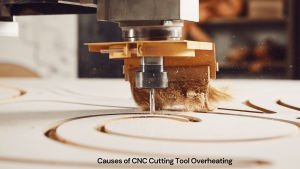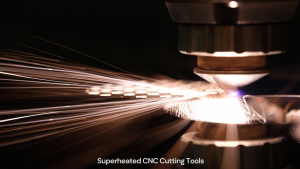CNC cutting tools have a significant presence in all manufacturing companies. These instruments are used for turning the given material, say, métal, bois, and plastic, into the desired sizes and shapes we may want. They have been influential in the designing of the most exact and detailed objects, Et ainsi, they can’t spare them since they are vital in several industries such as automotive, aérospatial, et électronique. D'autre part, making machine tools that use CNC cutting tools sometimes causes the machines to heat up. One of the most fundamental steps in saving these devices from internal damage is realizing the sources of overheating and their consequences.
Heating in CNC cutting tools is when the tool’s temperature exceeds its specified operating temperature. These higher temperatures allow the tool material to work, harden, and deform, reducing its performance and overall life span. Such problems can arise, for example, by shortening the working time of the tool, unsatisfactory surface quality, increased insert breakage, an error in machining accuracy, and raising production costs. Ainsi, overheating can lead to several consequences that are worth every concern to manufacturers. Hence, manufacturers must have considerable knowledge to develop preventive measures to avert the overheating problem.
Causes of CNC Cutting Tool Overheating

Dans un outil de découpe CNC, which is a major factor in overheating, many things can be identified as the culprit. The main reason is the distance and the shear stress in regions of bearing contact. While the tool runs through the specified material, it generates heat by friction. Excessive weight of the tool can cause overheating if the heat is kept intact since it does not escape.
Lack of effective cooling or lubrication is another important factor responsible for the machine’s overheating. A cooling and lubricating mechanism assists in significantly reducing the frictional forces and heat that might adversely affect the work. No or inadequate amount of coolant or lubricant leads to increased friction, which indicates intensification of heat production and an increased temperature.
Incorrect cutting parameters also play a leading role in tool overheating. CNC machine operators must optimally define cutting parameters like the cutting speed, vitesse d'avance, and cut depth adapted to the material being processed and to the specific tool utilized. Suppose this input is expressed as higher or lower values. Dans ce cas, cela conduit à une production excessive de chaleur simultanément au chauffage de l'outil.
L'usure ou les pannes des outils créent également de nombreux autres problèmes, comme chauffer. The heat dissipation capability of a device is its key function. When the device is worn out or abused, overheating becomes a common phenomenon. Mispositioning of the machine or tool holder may produce a similar condition in that the tooling temperature reaches a normal state.
Effects of Temperature Rise on Life and Durability of CNC Tools
Overheating of the CNC cutting tools is one of its undesired results, causing either an unwanted heat up of the tools themselves or undesirable heat formation in the machining process. It is one of the destructive effects felt like premature wear. The sharp cutting edge of the tool does not lose its edge quickly due to the cooling of the tool, Et ainsi, it has a longer life. One, it expedites the need for tool swap out; otherwise, the whole process becomes costly.
An unsatisfactory surface finish is another unfavorable impact of a tool that gets hot. When a tool overheats the material, it melts and deforms the material being machined. The quality of the surface finish is likely to be altered. Such inconsistency may become very troublesome for industries where aesthetics and precision are equally important(e.g., automotive and medical device manufacturing).
Psychotherapists frequently encounter drug-related content in their practice mostly because of the effect of the substance on their thinking and decision-making processes. Increased heat can result in the tool being metamorphosed and enlarging its fractures. The tool breakdown not only stops the machining of trying to look for repair but also poses a great danger to operators.
Entretien et réparation des outils de coupe CNC surchauffés
Si les outils de coupe CNC sont utilisés à des températures dépassant les valeurs recommandées, corrective operation and repair of the tools are required. The first thing to do is check over and measure the tool to determine how damaged or worn out it is. This will aid in identifying whether the tool can be saved through heat treatment or if it has to be replaced.

Si l'outil contient de la saleté ou des miettes, ceux-ci doivent être retirés soigneusement à l’aide d’une brosse ou d’un chiffon. Par exemple, among the proper cleaning methods to consider are ultrasonic cleaning or chemical cleaning based on the type of material being machined.
When resharpening is possible, the tool must retain the cutting edge by carefully reshaping its edge. This is achieved with the help of devices like ultrasonic grinding or honing. It is worth mentioning that over-sharpening eliminates the cutting edge and the tool geometry crucial to performance. Donc, it should be done carefully.
That said, illuminating and preventing overheating of the CNC cutting tools is so important for manufacturers as it helps prolong the tool’s life and also ensures efficiency. Overheating may result in reduced tool life, bad surface quality, a heightened level of risk of tool breakage, reduced accuracy of the machining process, and more expensive production costs. A proper choice of cutting parameters can decrease the process of heat build-up in the metals, as well as the use of adequate cooling and lubrication, entretien régulier des outils et des machines, coupe à grande vitesse, et une sélection appropriée du porte-outil. Dans les cas où cela arrive, des actions de maintenance et de réparation en temps opportun doivent être délibérément mises en œuvre pour réduire le délai d'attente et maintenir le système à son niveau de performance maximal. Ceci est possible en mettant l'accent sur la prévention de la surchauffe et en mettant en œuvre des procédures de maintenance corrective pertinentes., créant ainsi une durée de vie de l'outil plus longue, productivité accrue, et des coûts de production réduits.
